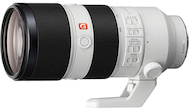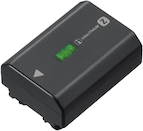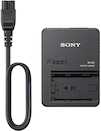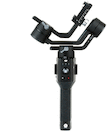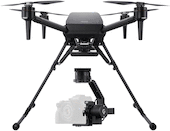The Sony Alpha a9 III is an ultra-fast, premium, full-frame mirrorless camera with a global shutter, and an update to the popular Alpha a9 II. Key features include:
24.6MP full-frame global shutter sensor
Up to 120 fps continuous shooting with AF/AE
Pre-capture feature; speed-boost button
1/80,000-second maximum shutter speed
What’s Changed? The Sony Alpha a9 III adds a variety of features that make it even better-suited to professional photographers than its predecessor. Most notably, it’s the first full-frame mirrorless camera to incorporate a truly global shutter, which represents a massive jump in performance over the rolling-shutter technology typically found in mirrorless cameras. It includes continuous RAW shooting at 120 fps, adjustable pre-burst shooting, crop-free 4K 120 fps video capture, S-Log3 and S-Cinetone modes, an updated autofocus system, CFexpress Type A and SD memory-card compatibility, and a refined body design with improved ergonomics.
24.6MP Full-Frame Global Shutter Sensor. The inclusion of a global shutter goes a long way toward setting the a9 III apart from other comparable cameras on the market. It works in conjunction with the BIONZ XR image processor to ensure uniform exposure across the frame in any lighting condition, permit 120 fps continuous RAW burst shooting, eliminate the risk of distortion when you’re trying to capture stills or video of a fast-moving subject, and allow for flash sync at shutter speeds up to the camera’s 1/80,000-second maximum. The global shutter sensor’s presence means there’s no need for a mechanical shutter.
Capture Your Shot No Matter What. The a9 III’s Pre-Capture feature lets you record images to the buffer when you half-press the shutter button, and the camera will save the resulting images to the memory card once you fully press the shutter. You can set the pre-capture recording time between 0.05 and 1.0 second. While you won’t necessarily need the a9 III’s 120 fps maximum speed at every shoot, you can use the conveniently positioned C5 button to immediately switch from your usual continuous-shooting frame rate to a faster one to make sure you get your shot.
Pro-Grade UHD 4K Video Capture. The a9 III can capture UHD 4K video in multiple frame rates up to 60 fps, which is downsampled from the full 6K image area. It can also capture 4K and Full HD 1080p video at up to 120 fps without a crop. You get internal 10-bit 4:2:2 recording using All-I encoding and 16-bit RAW output to compatible external recorders via a full-size HDMI connection.
S-Cinetone and S-Log. This camera includes the S-Cinetone color matrix that was previously seen in Sony’s Cinema Line cameras like the VENICE and FX6. You can use the S-Cinetone color profile to produce healthy-looking, accurate skin tones; beautiful, well-controlled highlights; and soft, distinct colors. You also get S-Log3, which will give you a 15+ stop dynamic range with greater control over grading in the shadow to mid-tone areas of your image.
AI-Based Hybrid Autofocus System. This updated Fast Hybrid autofocus system, which you can use for stills and video, features its own dedicated processor and a host of advanced features. It incorporates a dense grid of 759 on-sensor phase-detection autofocus points in stills mode and 627 on-sensor phase-detection points in video mode, which covers 94% of the camera’s image area, and provides extremely fast, accurate performance in a range of lighting conditions down to -5 EV. The a9 III retains its predecessor’s AF Point joystick and dedicated AF On button.
Autofocus Tracking Features. The a9 III’s autofocus system features a range of AI-based tracking features, including a new Human Pose Estimation mode that improves on previous human-recognition modes by tracking the same person even if their movements indicate that a different person in the frame is a more obvious subject. An Auto Framing mode seamlessly auto-crops for optimal framing when you’re shooting movies, giving the impression that a camera operator is following the subject and greatly simplifying camerawork that would otherwise be a lot for a single person to take on. You can use the touchscreen to adjust for speed, sensitivity, and subject positioning, and Auto Framing even works when you’re using the Creators’ App with your smartphone to remotely operate the camera. In addition to tracking humans, the AI autofocus system can also track animals, birds, insects, cars, trains, and airplanes with greater accuracy than the first-gen a9 III. It recognizes some small and grazing animals’ eyes, and it can recognize the eyes and heads of dogs, cats, and other animals with similar features. I’m sad to report that Sony still isn’t revealing why birds and insects aren’t categorized as animals, though.
Five-Axis SteadyShot INSIDE Image Stabilization. The updated SteadyShot INSIDE image-stabilization system offers up to eight stops of correction onto any lens you mount to the camera. This system compensates for five types of camera shake, including angular shake (pitch and yaw), shift shake (X and Y axes), and rotational shake (roll). All five stabilization axes are constantly engaged, even when you’re using lenses with their own built-in image stabilization, third-party lenses, or adapters.
High-Res EVF and Tilting Rear Touchscreen LCD. The improved QVGA OLED EVF boasts 9.44m-dot resolution, 100% coverage, and 0.9x magnification to give you a bright, clear view of what the sensor sees. It allows for up to 240 fps playback for smooth motion rendering with minimal motion blur. The tilting 3.2-inch 2.1m-dot rear vari-angle touchscreen LCD can also be used for image composition and review when shooting at arm’s length, in addition to offering intuitive shooting and autofocus control, and menu navigation. It uses a DCI-P3 wide gamut for accurate color reproduction.
Improved Body Design. The a9 III’s durable dust- and moisture-sealed magnesium-alloy body features markedly improved ergonomics compared to that of the a9 II. It has a substantially redesigned grip with a deeper, curved-in hand-hold that directs your finger to the shutter button and makes the camera even more comfortable to use on extended shoots with larger, heavier lenses. You also get reconfigured controls for ease of use, including a C5 custom button on the front of the camera body and two raised custom buttons behind the shutter release. Dual CFexpress Type A / SD card slots give you flexible file-storage options that take full advantage of the a9 III’s high speed, and a shading curtain, which is automatically activated when you power off the camera, protects the sensor from debris and the elements.
Monitor and Control. As of November 2023, you can use Sony’s Monitor & Control app for Android and iOS to turn your smartphone into a wireless video monitor. It lets you use your phone to remotely control the camera, display and control clips from the camera, start and stop recording, adjust white balance, change ISO, adjust color settings, and swap between LUTs.
Other Notable Features. New to the a9 III are an improved voice-memo function with clearer recording, memos that you can transfer via FTP, and voice-to-text message-conversion with Sony’s Transfer & Tagging app; the ability to automatically add IPTC metadata to images and save up to twenty presets; and image bursts that you can set to display as a group during playback for easier navigation. Carried over from the a9 II are the 1000BASE-T speed Ethernet port, the ability to store up to ten sets of both FTP and camera settings via the Imaging Edge mobile app, the NTSC/PAL-switchable Slow and Quick Motion mode, the Multi-Interface Shoe and PC-terminal external-flash connections, and built-in Wi-Fi and Bluetooth capabilities for wireless image sharing and camera control. Rounding all this out is the NP-FZ100 Battery, which is rated for up to 400 shots per charge with the viewfinder and up to 530 shots with the LCD. If you need more power, the separately available Sony VG-C5 Vertical Grip offers increased battery life.












